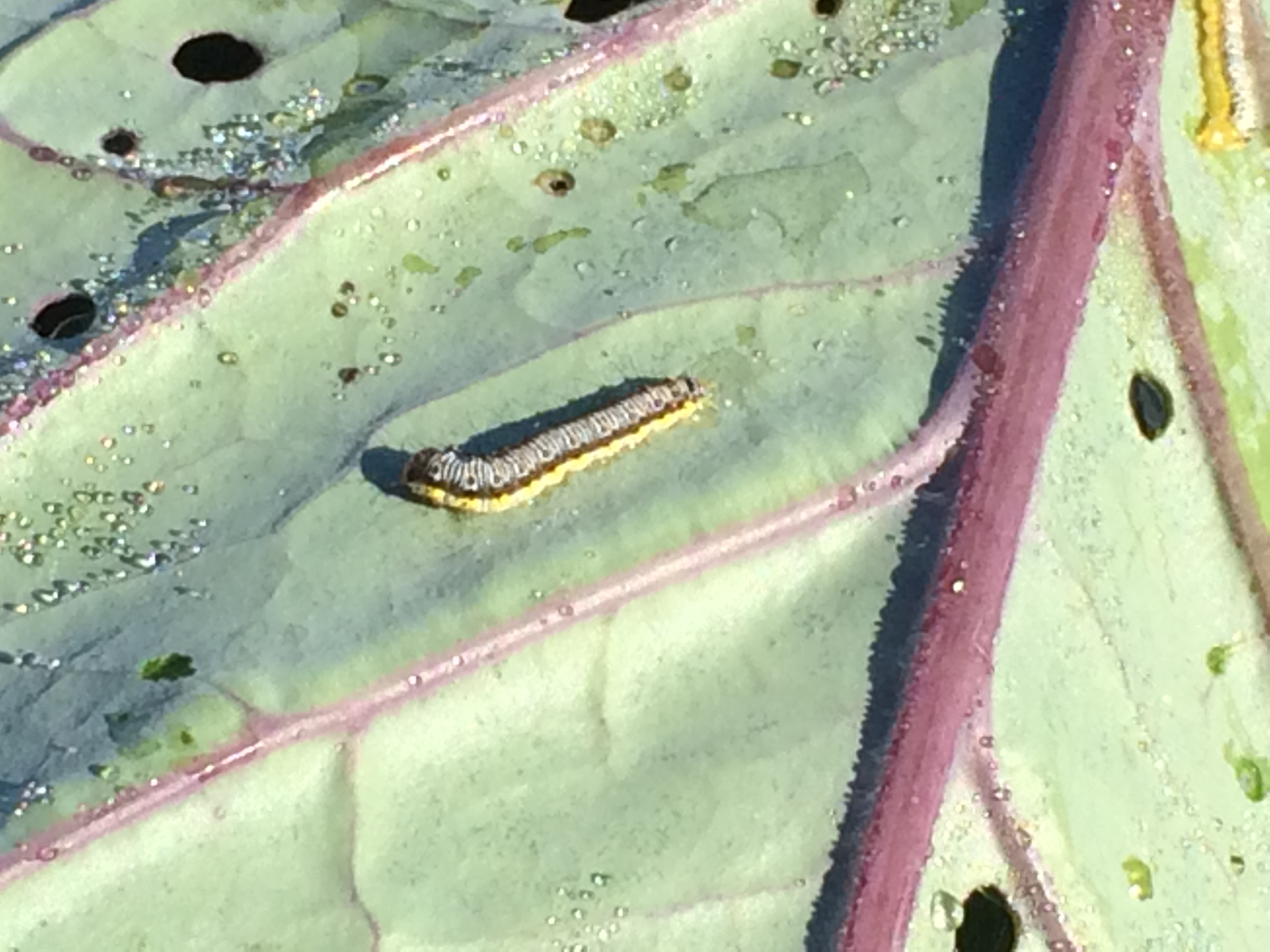
by Blake Thaxton | Oct 21, 2014
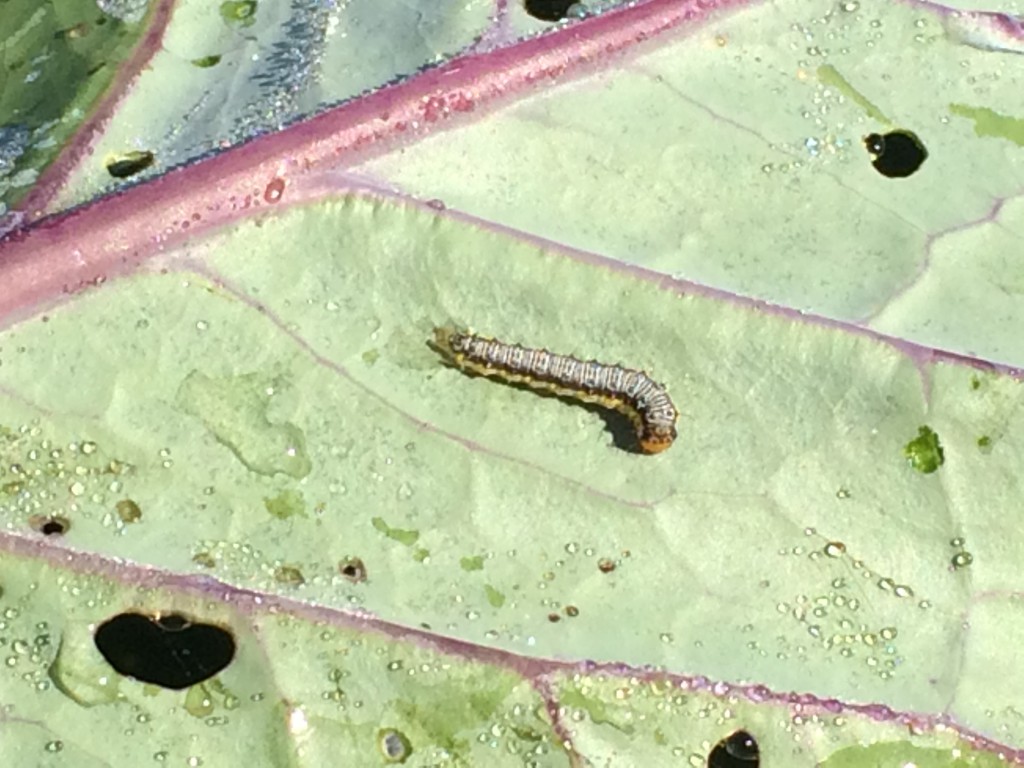
Cross-Striped Cabbageworm – Photo credits: Blake Thaxton
Panhandle gardeners have their fall gardens planted and our growing rapidly. What the gardeners may start noticing is shotgun damage to cabbage leaves in their garden. The suspect for this damage is the Cross-Striped Cabbageworm.
The Cross-Striped Cabbageworm have black and white markings on the back of the caterpillar and a bright yellow stripe on each side. This particular caterpillar feeds in cluster and maybe limited to a hot spot of a few plants in the garden or production area. They feed on tender parts of the cabbage including the terminal bud and can feed into the head once heading is initiated.
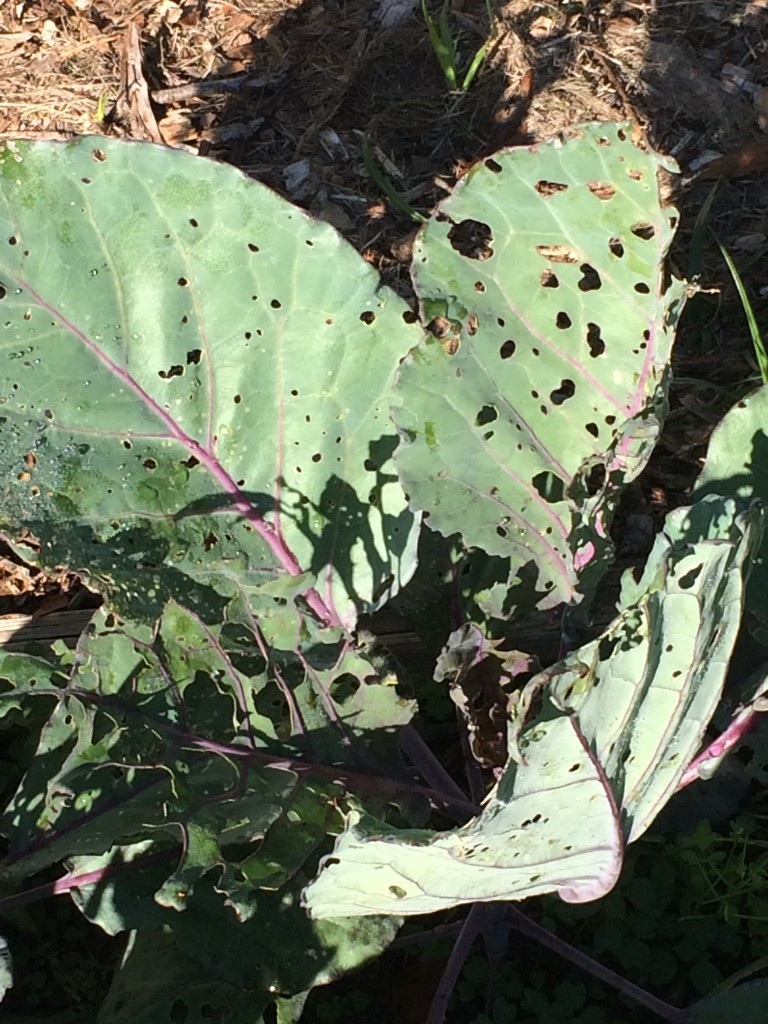
Damage caused by Cross-Striped Cabbageworm – Photo Credit: Blake Thaxton
With all pest control the three levels of control should be used:
- Level 1: Systems-based practices – weed control of pest host weeds
- Level 2: Mechanical and physical practices – A barrier, such as a light cloth that still allows enough light, can be used when the plants our young to prevent the moths from laying eggs on the cabbage.
- Level 3: Soft chemical & other materials – Bt (Bacillus thuringiensis) products can be used on the small-sized caterpillars. Harsher chemicals can kill the adults but in a garden situation picking them off and disposing them in a bucket of soapy water will do the trick as well.

by Mary Salinas | Oct 21, 2014
This autumn you may notice shrubs with long, arching branches sporting clusters of shiny purple berries. That beautiful sight is the Beautyberry, or Callicarpa americana. This native is found throughout Florida and the southern United States, west into Texas and north to Tennessee and Virginia.
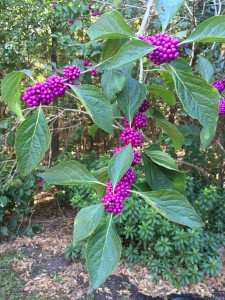
Beautyberry in the fall. Photo credit: Mary Derrick, UF IFAS Extension.
In the spring, lavender flowers adorn the branches and are a favorite of bees. The flowers eventually give way to the shiny purple berries in the fall. Birds find the berries very attractive and will feast on them when found. Mockingbirds and cardinals are especially fond of them. If you plant this shrub for the birds, one or two plants will provide more than enough of the berries to satisfy their appetites.
Beautyberry is adaptable to a wide variety of soils and moisture. After it gets established it is drought tolerant, however it can also do well in a moist area. A spot in your garden that gets partial sun is a perfect location. Plants in too much sun sometimes get a bit yellow and those in too much shade get leggy and don’t set as much fruit. Beautyberry is deciduous, meaning that it will lose all its leaves in the winter. Therefore, you may want to place it in an area of your yard where it won’t be a focal point in the winter.
This lovely plant is usually readily available at independent nurseries. If you prefer to grow your own, beautyberry is easy to propagate and grows rapidly. Snip off an approximate 6-inch piece from the end of a stem; the cut piece should have 5 sets of leaves. Snip off the bottom 2 sets of leaves – this part of the stem will be in the soil and roots will emerge from where the leaves were removed. Also snip off the top of the stem to include the top set of leaves. Your cutting will end up with only 2 sets of leaves. Immediately put the cutting in a good potting soil, making sure that the lower part of the stem where the 2 sets of leaves were removed is below the soil line. Keep the soil moist as the cutting develops a good root system.
You and the birds will enjoy this lovely shrub for years to come!
by Les Harrison | Oct 20, 2014
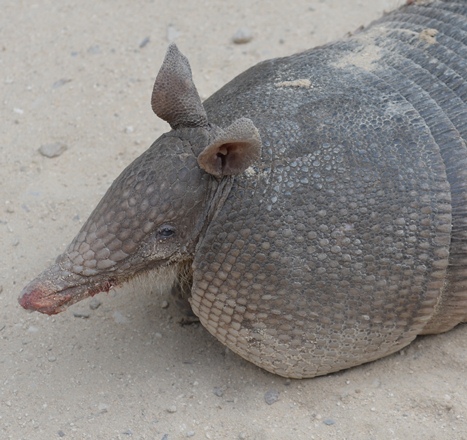
Appearing clumsy and bumbling at first glance, these exotic invaders quickly damage landscapes in search of tasty insects.
It can be pretty discouraging to step out one morning to find a lawn pock-marked like the lunar surface. Stunned surprise then anger is usually the owner’s response.
The offender is not the neighborhood teenager with a reputation for inappropriate practical jokes. The offender is most likely an armadillo, sometimes identified as a Florida-speed-bump or a Possum-on-the-half-shell.
Armadillos eat mostly adult insects and their larvae. They incessantly dig holes in lawns and landscapes in their search for food, many times uprooting plants and turf in their food search. Their holes are approximately one to three inches deep and three to five inches wide.
Using insecticides to decrease the armadillo food supply is not guaranteed, but may help reduce the digging. In cases where there is a large, and always ravenous, armadillo population this reduction of food may increase digging activity as they search more diligently for a smaller food supply.
Another consideration is all chemical treatments have to be re-applied on a permanent basis for impact. Always read and follow label instructions for safe use of insecticides.
To add insult to landscape injury, armadillos burrow under driveways, foundations and patios potentially causing structural damage. Additionally, their burrows in pastures pose a potential leg-injury hazard to livestock.
Burrows openings are approximately seven to eight inches in diameter, about the size of a one-gallon plastic jug, and up to 15 feet in length. The sandy soil is piled up right outside the burrow entrance. Armadillos usually rest in a deep burrow during the day and are most active after dark.
Because armadillos are nocturnal, trapping techniques designed to capture them as they emerge from their burrows should be applied late in the afternoon and checked several hours after darkness. Fencing is another potential option to discourage the presence of armadillos.
Several live-trapping techniques can be used to capture armadillos as they exit of their burrows. One method is to firmly insert a six-inch diameter PVC pipe into the entrance of an active burrow. Adult armadillos will get stuck in the pipe as they try to exit. Another option involves a nylon throw-net staked down to cover the burrow entrance. Armadillos will get tangled in the net as they emerge.
Some can be discouraged from returning to their burrows by filling the hole with a mixture of dirt and mothballs after they have departed for a night of foraging. Laying chicken-wire along a patio, driveway or house foundation will discourage burrowing.
Armadillos can also be trapped using a raccoon-size metal trap, available from local pest control, feed and home improvement stores. These animals are more likely to enter a cage trap with leaf litter or soil placed over the wire bottom.
Suggested baits for the trap are live earthworms or meal worms in surrounding soil placed in hanging bags made of old nylon stockings. Overripe or spoiled fruit which will attract insects may be used as bait. Poison baits are illegal and no chemical repellents or fumigants are registered for use in Florida.
Relocating problem animals is not recommended because it only transfers the problem elsewhere and can spread disease.
To learn more about controlling armadillos contact your local UF/IFAS Extension Office or read Baiting the Nine-banded Armadillo at http://edis.ifas.ufl.edu/uw362
by Beth Bolles | Oct 14, 2014
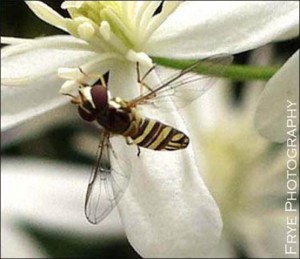
Hover Fly. Image Credit EDIS, Roy Frye
When someone mentions flies, we think of buzzing around our heads, maggots in decomposing materials, and unclean conditions. It is time to change those thoughts, at least in the garden. There are several flies commonly found in landscapes that provide a valuable service in pest management. The long-legged fly is a beautiful fly that is normally metallic copper, blue or green. It is very slender with long, thin legs and is common in most gardens. The larvae or maggots can be found in moist soil or rotted vegetation and like the adults are predaceous on aphids, thrips, mites, and other small-bodied arthropods. The hover fly is also found around flowers and has the rare ability to hover and fly backwards. Because of their yellow-striped abdomen and similar coloring, these flies are often mistaken for bees. Adults visit flowers for nectar and help with pollination while the larvae primarily feed on aphids.
The tachinid fly, is similar to the house fly in appearance, but is an excellent parasite of pest caterpillars, beetles and bugs. The adults are gray or black in color with stiff hairs on their bodies. The larvae spend their lives feeding inside the bodies of unwanted insects and are so valuable that exotic tachinids have been introduced into North America as part of biological control programs.
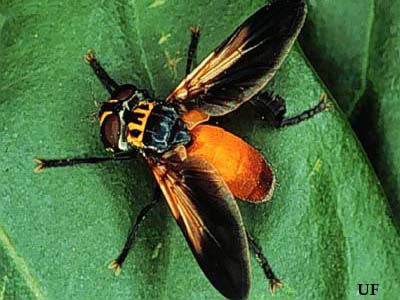
Tachinid Fly. Image Credit UF / IFAS Entomology Department
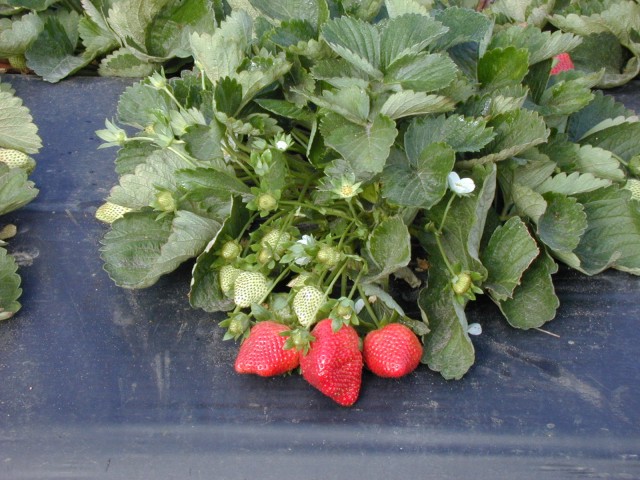
by Matthew Orwat | Oct 14, 2014

Sweet Charlie Strawberry. Credit: C.K. Chandler, UF IFAS Extension
Now is the time for Northwest Florida gardeners to plant strawberries for bountiful production of fruit beginning in January and continuing into May. The following procedure will lead to a successful strawberry garden if followed:
The best location for strawberry production provides well-drained, moist, sandy soil with substantial organic matter. It must not be too wet. A fertilizer scheme of 2 lbs of a 6-8-8 fertilizer per 100 sq ft should be broadcasted over the plot, and spaded or disked in. Prepare the bed by leveling out the soil. Commonly, a preferred system is the development of a hill system, which entails making a raised bed 6-8 inches high and 24 inches wide. A raised bed can be filled with well-rotted compost mixed at a 50:50 rate with soil. After bed preparation, provide another application of fertilizer in a single, narrowband in the middle of the bed, 4 to 8 inches deep, but DO NOT apply fertilizer directly below the plants, as the fertilizer may burn the young transplants. Do not use fertilizer with more than 6% nitrogen on strawberries, so that they have less chance of burning and greater chance of setting sweet, quality fruit.
Short day, certified disease free plants for Florida such as Sweet Charlie and Camarosa should be purchased from a reputable nursery.
If growing the plants using plastic mulch or grow fabric, put drip irrigation underneath in the form of drip emitters or bubbler type soaker hose.
When setting out the transplants:
- Keep plants moist before planting
- Spread roots out in fan-shape
- Set plants in moist soil at the correct depth. Do not cover the plants crown with dirt or leave its roots exposed above the soil.
- Space plants 12 to 18 inches apart.
- Pack the soil firmly around the roots, then sprinkle with water. Overhead sprinkling may keep the tops from drying out until the roots can get established.
For best results, strawberries should be mulched. Black polyethylene plastic mulch at 1 to 1½ mil thick is best (completely cover the top and sides of bed before planting). Be sure the bed is firm, formed correctly, moist, and fertilized adequately. Place soil on the edges of the plastic to hold it in place. Cut slits in the plastic for the transplants.
When using alternatives like straw, bark or other natural organic materials mulch to a depth of 1 to 2 inches, but do not completely cover the plant.
For more information on growing strawberries contact your local UF IFAS Extenison office or read this publication on strawberry production.










